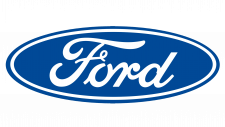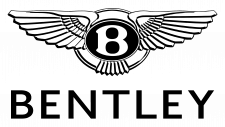Jeep Logo
Jeep, an iconic automobile brand, primarily manufactures rugged, off-road vehicles. Known for its legacy of producing durable 4x4s, its current lineup includes models like the Wrangler, Cherokee, and Grand Cherokee. Jeep has a strong foothold in North America but has expanded its presence globally, catering to markets in Europe, Asia, and beyond. Presently, Jeep operates under the umbrella of Stellantis, the multinational conglomerate resulting from the merger of Fiat Chrysler Automobiles (FCA) and PSA Group. Today, Jeep continues to innovate, embracing sustainability with plans for electrification.
Meaning and history
Jeep, with its wartime origins, began as Willys-Overland Motors in the early 1940s, producing the first military Jeep vehicles for World War II. This rugged, reliable vehicle quickly gained popularity, cementing Jeep’s reputation for durability. Post-war, the brand transitioned from military to civilian use, launching the CJ (Civilian Jeep) series.
In the mid-20th century, ownership shifts began. Kaiser Motors acquired Willys-Overland in 1953, renaming it to Kaiser-Jeep in 1963. However, in 1970, American Motors Corporation (AMC) took the reins.
The 1980s saw another change: the French automobile manufacturer Renault acquired a significant stake in AMC. This period witnessed a fusion of design and technology, with the birth of the iconic Jeep Cherokee (XJ).
However, in 1987, Chrysler acquired AMC, marking a significant milestone in Jeep’s history. Under Chrysler, Jeep flourished, introducing models like the Grand Cherokee.
The 21st century brought more transitions. In 1998, Daimler-Benz merged with Chrysler, forming DaimlerChrysler. This union lasted until 2007 when Chrysler was sold to Cerberus Capital Management, a private equity firm.
In 2014, a pivotal merger between Fiat and Chrysler resulted in the creation of Fiat Chrysler Automobiles (FCA). Jeep’s global footprint expanded further during this era.
2021 was another monumental year. FCA and PSA Group merged to form Stellantis, the current parent company overseeing Jeep. Today, Jeep maintains its legacy of crafting off-road vehicles while embracing modern innovations and sustainability.
1941 – 1945
Originating from an era of collaborative innovation, the emblem integrated the monikers of three pivotal firms: Willys, Bantam, and Ford. This was when military needs birthed the idea of a lightweight SUV. Each company had their foundational design sketches, pooling their expertise to the shared goal. Displayed prominently in bold crimson was the name “Jeep,” beneath which the trio of automakers’ names were inscribed: “WILLYS. BANTAM. FORD.” Their sequence denoted the chronological order in which the U.S. military approached them. While Willys pioneered the initial design, Bantam enhanced the blueprints, and Ford expedited its large-scale production. Interestingly, separating these names weren’t customary dots at the base but rather uniquely positioned at the center.
1945 – 1963
From 1945 onward, the badge underwent significant simplifications in terms of components and color palette. The original names of the collaborating companies were stripped away, leaving only the term “Jeep,” now cast in a deep shade of ebony. The typography was magnified for clarity, transitioning into a revamped font style. To accentuate its significance, the word was flanked by slanting lines at both its commencement and conclusion, symbolizing quotation marks. Except for its initial letter, the typography was transformed into lowercase, and almost all characters, barring the “e”, showcased distinct serifs for a refined touch.
1963 – 1970
In 1963, the automobile manufacturer adopted a fresh emblem, incorporating innovative design elements. This newly minted logo featured a foundational circle, endowed with a metallic sheen around its periphery. Such a design choice was made to create an illusion of depth and a mirror-like reflection, achieved through strategic placements of light and shadow.
The core of this circular emblem was partitioned into five distinct segments: a central horizontal rectangle flanked by four curved-edge triangles. These shapes alternated in hues of olive green and a muted shade of red. Positioned at the heart of this design, on a pristine white band, was the brand’s moniker, rendered in a matching olive tint.
1970 – 1987
The dawn of the 1970s witnessed a typography evolution for the brand, embracing a refined, unembellished, sans-serif font. Designers opted for the distinguished Neue Haas Grotesk, rendering it in a bold shade of black. This pivotal change in font choice cemented the brand’s identity, leading to a consistent visual representation. The iconic “Jeep” lettering, to this day, retains this specific style, reflecting both its historical roots and its commitment to simplicity and modernity. The persistence of this design choice underscores the brand’s value in continuity and its ability to adapt while honoring its legacy.
1970 – Today
The creative team integrated a symbolic emblem alongside the original text, incorporating two distinct figures: an inclined red triangle and an upright blue rectangle. These shapes were crafted with intentionality, representing the initials “JP” – a concise nod to the brand name “jeep.” Drawing inspiration from minimalism, the team ingeniously used these geometric forms to provide a visual interpretation of the brand’s initials, merging simplicity with brand recognition. This innovative approach not only modernized the brand’s identity but also ensured its lasting impact through an elegant blend of tradition and contemporary design.
1987 – 1993
Building upon the foundational text, the creative team reimagined a distinct badge. Transitioning the font’s hue from a deep black to a pristine white, they incorporated a slender five-pointed celestial figure. This star, though seemingly simple, carries a geometric intricacy. It boasts five defined sides, with its top two converging to shape a wide-angled peak. Notably, this pentagonal form pays homage to Chrysler, serving as a nuanced nod to its signature emblem. The backdrop for this design evolution is a sleek, dark-hued rounded square, which further accentuates the brightness of the white font and star, capturing the essence of contrast and legacy in one cohesive visual representation.
1993 – Today
Today’s emblem embodies the essence of the automobile brand, drawing inspiration from the design ethos established in 1970. This prominently displayed nomenclature is drenched in a rich shade of forest green, contrasting beautifully against an immaculate alabaster backdrop. It’s a testament to the brand’s history, seamlessly blending classic design elements with contemporary aesthetics. The choice of such a timeless hue reflects the company’s commitment to its roots, while the minimalist backdrop ensures the focus remains on the brand’s iconic name. Through the years, this design has proven its mettle, resonating with the timeless appeal and heritage of the brand, ensuring it remains relevant in an ever-evolving automotive landscape.


















